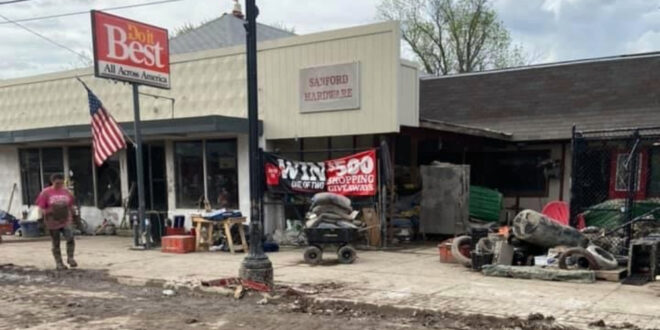No matter how many times disaster strikes, nothing can fully prepare you for handling an extreme weather incident. However, you can learn from the past and use that knowledge to weather through the best you can. Such was the case for Bob Nelson and his wife Linda Nelson, who are the owners of Nelson Ace Hardware in Barre, Vermont, which experienced a massive flood in the summer of 2023.
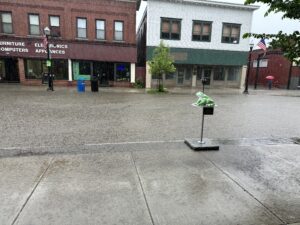 “We had a very wet spring so the ground was saturated,” Bob says. “We were supposed to get a fairly heavy rain, they thought maybe we’d get three to four inches of rain, but it just kept raining. By that afternoon, water in the street was lapping up over the edge of the sidewalk.”
“We had a very wet spring so the ground was saturated,” Bob says. “We were supposed to get a fairly heavy rain, they thought maybe we’d get three to four inches of rain, but it just kept raining. By that afternoon, water in the street was lapping up over the edge of the sidewalk.”
The Nelsons had been through a similar situation when the area flooded in 2011, so Bob knew what to expect—or so he thought.
“I had my employees get the items outside off the street and got them home, but by 5 p.m. the water was over the sidewalk and lapping at the doors,” Bob says. “It was just 15 minutes later, as I was leaving, that water was pouring into the basement. I went home and told Linda, ‘We may lose everything.’”
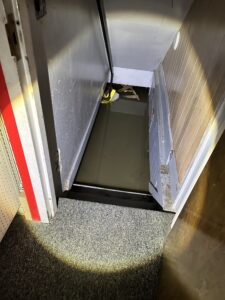 Watching and listening to the news the next morning, Bob and Linda stayed in contact with emergency responders. When they were able to return to the store, they opened up the door to the basement to find water all the way to the top step and between $200,000 and $300,000 worth of inventory destroyed. The Nelsons and their employees immediately began shoveling mud out of the first floor of the store, running the carpet cleaners and pumping water out of the basement with only power in one of the store’s three buildings.
Watching and listening to the news the next morning, Bob and Linda stayed in contact with emergency responders. When they were able to return to the store, they opened up the door to the basement to find water all the way to the top step and between $200,000 and $300,000 worth of inventory destroyed. The Nelsons and their employees immediately began shoveling mud out of the first floor of the store, running the carpet cleaners and pumping water out of the basement with only power in one of the store’s three buildings.
“As much as it pained me, we stayed closed all day that Tuesday while we tried to get ourselves together,” Bob says. “I called the Ace Hardware in Wilton in the middle of Tuesday and told them we needed product. They said they would have it to us in the morning, and true to their word, they were here at 7 a.m. the next morning with what we needed.”
That Tuesday, the crew was able to pump out all but a foot of the water from the basement, but overnight the sprinkler pipes were repressurized, bursting a sprinkler pipe and flooding the basement for a second time. While pumping the water out again, the water stopped receding because of a broken water pipe—three floods in 24 hours.
“I knew we were limping, but I also knew people needed product, they needed us to be their hardware store,” Bob says. “We were helping people with flashlights in two of the buildings because there was no power. I didn’t advertise that we were open because our phones didn’t work, so we couldn’t answer them. But we did our best, and I think we helped a lot of people.”
 After about a week of handwriting receipts and having no access to the POS, the internet was restored and after around six weeks, Bob says the operation was back to operating at almost 100%.
After about a week of handwriting receipts and having no access to the POS, the internet was restored and after around six weeks, Bob says the operation was back to operating at almost 100%.
Through it all, Bob gives all the credit to his staff for getting the store up and running.
“Our staff is regularly the highest scoring customer engagement team within the Northeast, and that showed through during this time,” Bob says. “I’m extraordinarily proud of my staff.”
No matter how many times it happens to you, Bob says you can never fully prepare for a weather disaster like this. But there are several steps retailers can take to be as prepared as possible.
For Nelson’s Ace, which prides itself on having a large selection of inventory, preparation looks like reducing inventory in some areas and taking more frequent deliveries from the operation’s wholesaler.
“Nelson’s has excelled at making sure we have inventory and our customers can count on us having what they need,” Bob says. “But we’ll continue to make changes to prepare for what might come down the line.”
After the catastrophic flood in 2011 and then again in the summer of 2023, the Nelsons put together a playbook to guide them for the next time disaster struck. They had a plan for prepping for weather, but lacked a solid plan for what happens after a weather event. The playbook includes tips like ordering a dumpster right away for any debris or damaged goods, having plenty of rubber gloves and mask in stock and establishing where you’ll store product temporarily if your store or warehouse is damaged.
“It’s all about having a plan in place so when or if a major weather event happens, you’re prepared for yourself but also prepared to serve your community,” Nelson says.
Disaster-Ready
A Playbook to Prepare for Weather Emergencies
After experiencing a devastating flood in 2011 and again in 2023, the Nelson came up with a playbook for handling a flood before and after. While their playbook is specific to handling a flood, the information contained in it offers helpful insights to handle any weather emergency.
Pre-Flood
- Always expect the worst, and plan for it.
- Make sure your computer systems are backed up and not stored below ground level.
- Make sure whatever protections—such as sump pumps—you have in place are functioning properly.
- Have phone numbers stored somewhere outside your business for contractors, rental companies, insurance, State Hazardous Material hotline, FEMA, small business administration and power suppliers.
Post-Flood
- Make sure all power issues are taken care of prior to entering a flooded building.
- Call and arrange for trash dumpsters once your business is secured, as they will be in short supply if your area is flooded. Same for storage containers if you think you’ll need them.
- Contact your insurance company so a claim can be started.
- If you are not handling cleanup in house, contact your contractor of choice and arrange to get on their list.
- Find a source for generators and gas-powered pumps and fuel for them.
- Other items you’ll want on hand: dehumidifiers, fans, tyvek suits, rubber and disposable gloves, masks, power cords, flashlights, headlamps and batteries.
- Assess whether there are hazardous materials in the flooded area.
- If utilizing your own staff for clean-up, arrange for bottled water, snacks, meals, etc.
- Utilize social media and traditional media to get the word out about changes in hours and whether volunteers are needed.
Relying on Community After the Flood
When flood waters inundated Sanford Hardware in 2020 after a dam in the area broke, owner Dennis Sian turned to his community of Sanford, Michigan, for help.
The building was still standing but had over 12 feet of water and silt had moved through the structure, creating damage that would have been too costly to repair, says Dennis’ daughter and store manager Christine Duhaime. The store lost nearly all of its inventory, save for a few items that were salvaged thanks to the help of friends and the community.
 “Our Simplicity lawn tractors were tended to for days by mechanics and friends with mechanical knowledge, and they were able to prevent major damage and restore them to a salvageable value,” Duhaime says. “We did clean a lot of the inventory and tried to sell some of it in a fundraising sale we held later.”
“Our Simplicity lawn tractors were tended to for days by mechanics and friends with mechanical knowledge, and they were able to prevent major damage and restore them to a salvageable value,” Duhaime says. “We did clean a lot of the inventory and tried to sell some of it in a fundraising sale we held later.”
Sian and his team rebuilt the store in the same spot and were able to reopen in 2021. Duhaime says her family’s commitment to put in the physical work and their community’s commitment to support the business were crucial to coming back stronger than ever.
“This tragedy didn’t only affect us but also several other businesses and hundreds of homeowners who also lost much or everything,” Duhaime says. “The timing of this tragedy was in the thick of the pandemic, but we still had hundreds show up to help us clean up and try to save our building as time was a critical factor in getting it dried out.”
For several weeks, Sanford Hardware welcomed volunteers from the community and across the country who showed up with shovels and equipment to help. Duhaime says insurance did not cover most of the losses, as was the case for most of their customers and neighbors that were also affected.
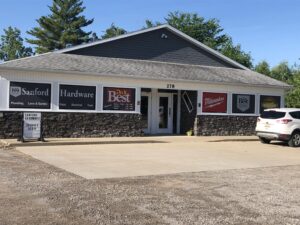 After the water had receded from the store, a good customer and friend offered his commercial building for the operation to use at no charge as a temporary store while Sian made decisions on rebuilding. The building was smaller than the original store—3,000 square feet compared to 10,000 square feet—but Sian was able to work with Do it Best to set up a small store set within 50 days of the flood. The new setup had the basics that allowed Sanford Hardware to serve the community in the interim.
After the water had receded from the store, a good customer and friend offered his commercial building for the operation to use at no charge as a temporary store while Sian made decisions on rebuilding. The building was smaller than the original store—3,000 square feet compared to 10,000 square feet—but Sian was able to work with Do it Best to set up a small store set within 50 days of the flood. The new setup had the basics that allowed Sanford Hardware to serve the community in the interim.
“We had our customer’s support long before then when they chose to drive 25 minutes to our second location in a nearby town to do their shopping as they knew it would support our family,” Duhaime says. “The influx in business in that store made two truck deliveries a week suddenly necessary and most of our employees from our Sanford location worked in that store while we assembled the temporary store. This was not a convenient option for our customers, as there are box stores within 10 minutes that they could have gone to instead, but they still showed up.”
Duhaime says they also held a recovery sale of the items they had cleaned and had many customers paying well over asking price for the items.
“They knew they were helping secure us back in town,” Duhaime says. “That, along with a generous Go Fund Me fundraiser, gave us hope and even more determination that we could make it.”
Along with the community and its customers, Sanford Hardware relied on its employees during this trying time. The operation didn’t lose any employees in the aftermath and were able to keep everyone on payroll. Most of the store employees transitioned to work in the other store in Clare.
“Their flexibility in driving much further to work and do everything in their control to help us get back on our feet was crucial,” Duhaime says. “They seemed to know how to respond and help to the best of their abilities.”
As Sian and Duhaime reflect on the last few months, they hold onto the lessons learned and share those with fellow retailers who are facing similar situations. While the dam breaking was a freak accident, they also took practical steps to prepare for future emergencies, including building the new structure more soundly and higher than the original structure. They are also now covered by an insurance policy that includes dam or levee failure.
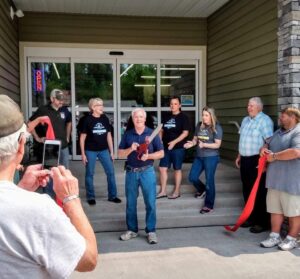 The biggest lesson they both take away is the importance of getting back up and keep going, even if it seems like an impossible situation.
The biggest lesson they both take away is the importance of getting back up and keep going, even if it seems like an impossible situation.
“The day after the flood was scary, and we were so unsure of the future, but the day after that saw a whole community show up with shovels and a gumption that was contagious and showed us that we would be alright,” Duhaime says. “We are truly fortunate to live in a community that cares for one another and really came together to help each other.”
Sian bought the store in July 2000 in the town he grew up in, so he is well-known to almost everyone. Duhaime says he put 20 years of service into not just selling hardware but helping people, whether that was getting a pump running when an elderly customer had water coming into their home, fixing a furnace for a customer on a Sunday night in January or any one of the other good deeds he did.
“You could say that our community paid him back when he was facing an unthinkable loss of 20 years of hard work,” Duhaime says. “We wouldn’t be back where we are today without them.”
 Hardware Retailing The Industry's Source for Insights and Information
Hardware Retailing The Industry's Source for Insights and Information



